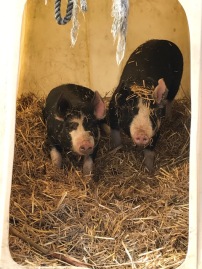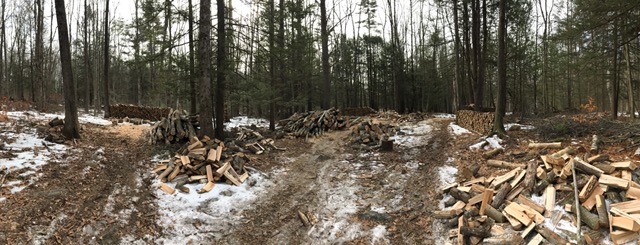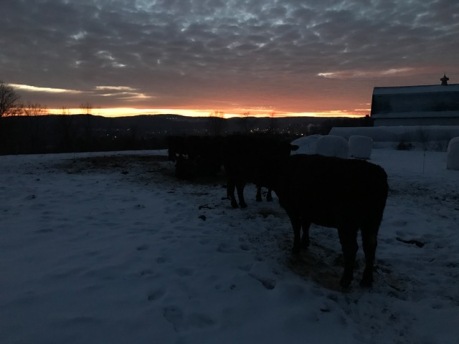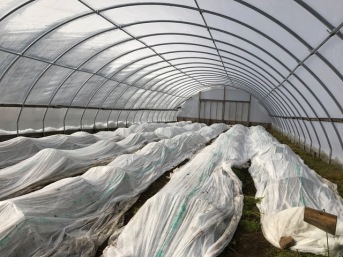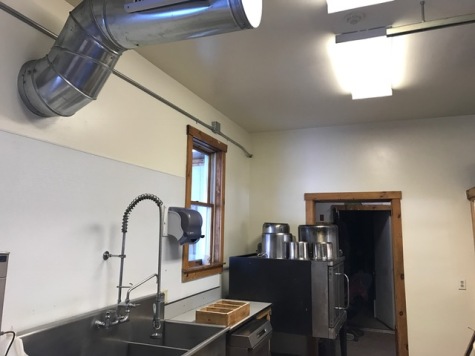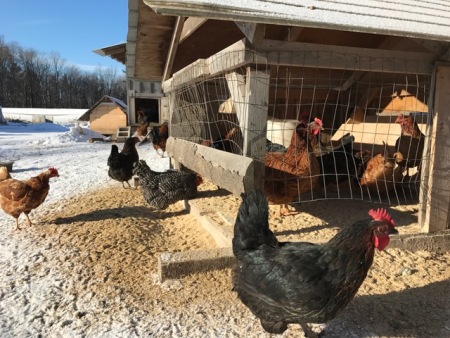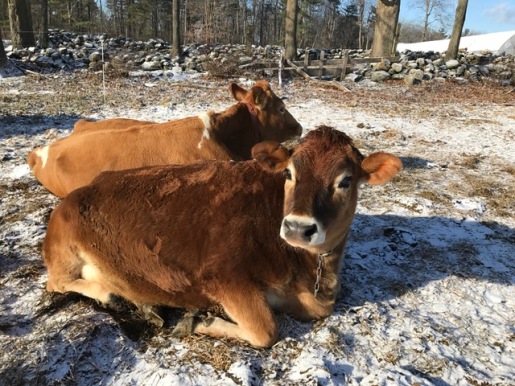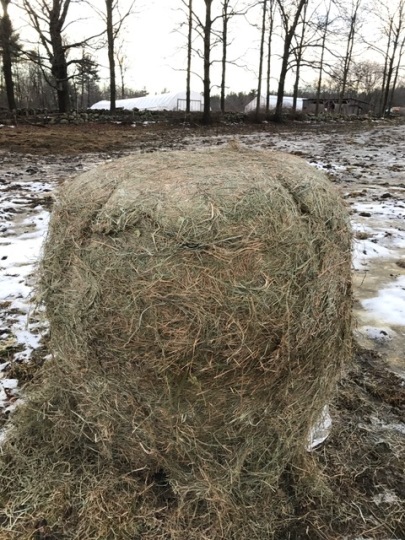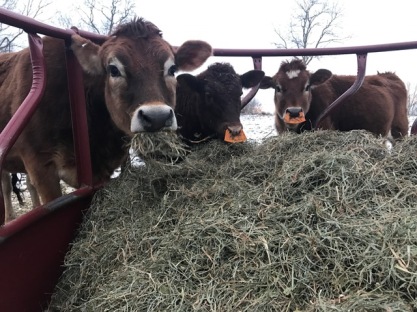
The student farmers at Maggie’s Farm have started their series of garden and field crop planning this week, starting with the basic principles of laying out the schedule and sequence of the growing season, then digging deeper into the details of how we ensure successful production to meet demand for all of our customers through the spring, summer and fall. This series of classes will give the students a chance to contribute to the crop plan for The Farm School’s cultivated acreage, as well as some time to imagine how they would map out their own potential vegetable production. In January, veggie growers all over New England are reading seed catalogues and dreaming big.
We have been working over the past few months to bring our sheep and layer operations into compliance with the specifications of the AWA, and we took another step forward this week with the completion of another larger chicken door on the winter coop at Sentinel Elm Farm. The AWA mandates that the chicken doors be large enough that no hen feels trapped inside, so we have been expanding the doors on both winter coops to accommodate a more free flow of hens in and out. I mentioned the start of this project last week, and I can report that we have finished both coops by now.
The next step will be do similar work on the summer ‘egg-mobiles’ used at both farms, but in that case we will be adding a second door, rather than one large door. We’ve ordered a second automatic door for the Maggie’s egg-mobile, so that both doors will have light sensitive controls opening and closing them at dawn and dusk. We also added a feed house out in the yard at the Maggie’s winter coop, hoping to encourage the hens to come outside more, and to give them some shelter out there.
We’ve gotten every student farmer through the firewood yard this week, re-introducing everyone to the hydraulic splitter, the chainsaws, the team of horses, and the mauls. Once everyone is comfortable using the requisite tools, and knows the workings of the yard pretty well, we can push production up to top speed, and try to get through this year’s quota as quickly as we possible.
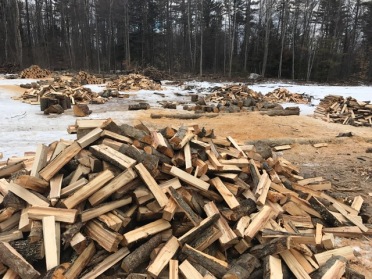
Every tool we use for making firewood is dangerous, and every step is physically demanding, so no matter how quickly we’d like to get the firewood split and stacked, the work demands care and attention.
Our chick brooder at Maggie’s has been a small outbuilding in the yard, originally built as a chicken coop. It is too small to accommodate the groups of chicks we work with for more than a couple of weeks, and we have been considering an upgrade for quite a while. We salvaged a small timber-frame structure from the sheep yard when we upgraded their situation this fall, and we’ve pulled it up near the barn to use as our new brooder house. This frame was the first built by Maggie’s student farmers way back at the start of the program, and we are currently trying to adapt it for its new purpose.
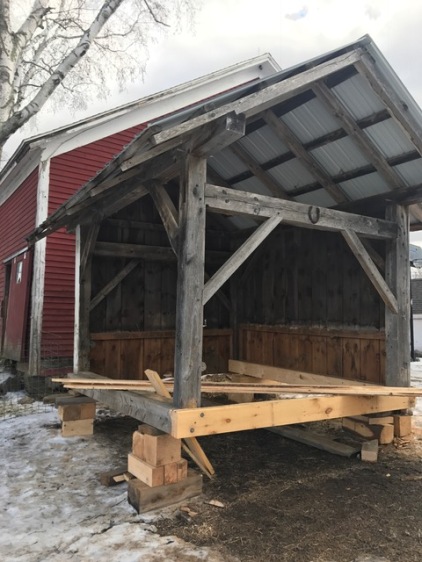
Time and use have twisted it a bit out of square, and the trip from the sheep yard didn’t do much to make it any straighter, so we’ve spent quite a bit of time this week trying to establish a level foundation, and a vision for how the whole thing will work best. We need to have a suitable brooder house ready for broiler chicks coming in the mail May 1st, and while that seems to be quite a way off, the spring is notorious for getting incomprehensibly busy all of a sudden in April, and we’re trying to get this thing finished before the crush of warmer weather. We’ll keep working on the project, and I will report back with progress.



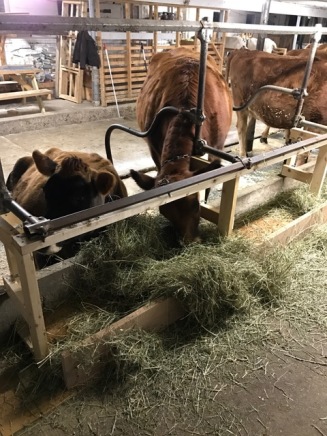
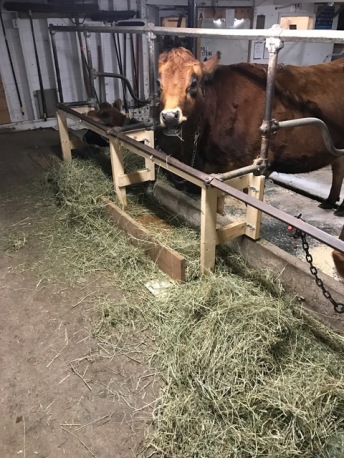 We have been working over the past six months to get our livestock operation AWA inspected and approved, and one of the changes that they asked us to make in their tour of the farm, was to enhance the chicken doors on our winter coops. We were given the option of adding a second door, or making a single door large enough that chickens could get in and out without disagreement. The concern of the AWA is that a chicken near the top of the pecking order could potentially stand in a small doorway, trapping chickens lower on the pecking order either inside or outside the building. On Monday, we boarded up the old door, cut a big hole in the wall, and installed a new large door with a gloriously large ramp. Whether the new door has really made a difference in the layer’s ability to go in and out more easily or not, the new door has certainly put a large hole in the side of the building, and we are going to need to come up with some type of bad-weather adaptation to keep that house at a more comfortable temperature when the weather gets cold and nasty. I hope to do the same project on the door to the winter coop at Sentinel Elm farm this week as well.
We have been working over the past six months to get our livestock operation AWA inspected and approved, and one of the changes that they asked us to make in their tour of the farm, was to enhance the chicken doors on our winter coops. We were given the option of adding a second door, or making a single door large enough that chickens could get in and out without disagreement. The concern of the AWA is that a chicken near the top of the pecking order could potentially stand in a small doorway, trapping chickens lower on the pecking order either inside or outside the building. On Monday, we boarded up the old door, cut a big hole in the wall, and installed a new large door with a gloriously large ramp. Whether the new door has really made a difference in the layer’s ability to go in and out more easily or not, the new door has certainly put a large hole in the side of the building, and we are going to need to come up with some type of bad-weather adaptation to keep that house at a more comfortable temperature when the weather gets cold and nasty. I hope to do the same project on the door to the winter coop at Sentinel Elm farm this week as well.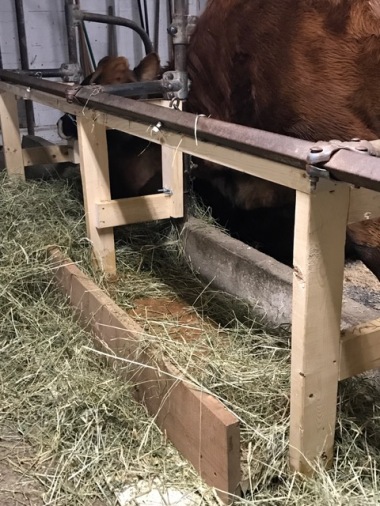 Despite some small vital changes that I need to make, the new dairy feeding trough seems to be working well. There were several factors that encouraged me in making this change, and it has been on my mind for quite a while. The current cow feeding area is a tiled floor space just in front of their tie-ups. It is a tough space to keep clean, with grout between the tiles, lots of foot traffic in and on the area, and the whole thing right down at floor level. Watching the cows essentially licking the floor to get the last few pellets of grain, especially in really cold weather, really started to bother me, and I took some measurements and sketched out a simple wooden frame and trough that could be built in.
Despite some small vital changes that I need to make, the new dairy feeding trough seems to be working well. There were several factors that encouraged me in making this change, and it has been on my mind for quite a while. The current cow feeding area is a tiled floor space just in front of their tie-ups. It is a tough space to keep clean, with grout between the tiles, lots of foot traffic in and on the area, and the whole thing right down at floor level. Watching the cows essentially licking the floor to get the last few pellets of grain, especially in really cold weather, really started to bother me, and I took some measurements and sketched out a simple wooden frame and trough that could be built in. 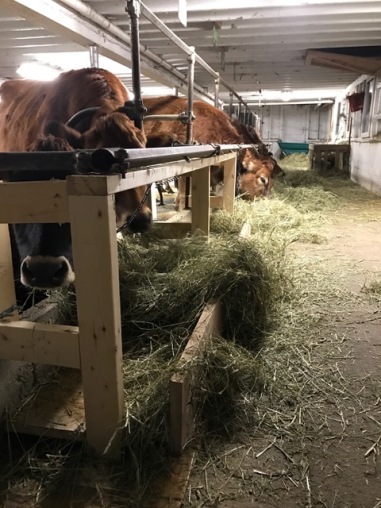 The frame is pine, the decking is hardwood, and whole thing means that the cows are licking on wood, rather than cold dirty tile, nobody can walk directly where they eat, and there is a lip to keep their grain accessible. The new space is more difficult to sweep out, but I am hopeful it will stay cleaner in general because the cows can access all of the area to eat, and can reach every bit of grain and hay.
The frame is pine, the decking is hardwood, and whole thing means that the cows are licking on wood, rather than cold dirty tile, nobody can walk directly where they eat, and there is a lip to keep their grain accessible. The new space is more difficult to sweep out, but I am hopeful it will stay cleaner in general because the cows can access all of the area to eat, and can reach every bit of grain and hay.